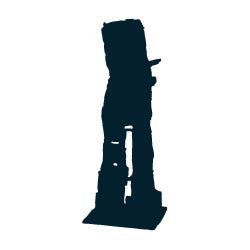Eduardo Paolozzi For Adolescents

Figure
Eduardo Paolozzi
Subject: Making a collage by juxtaposing elements
Activity: Create a collage robot
Materials: Magazines, catalogs, etc., along with paper, glue, and scissors
Vocabulary: casting, collage, juxtaposition, semiabstract
Edward Paolozzi was deeply affected by World War II. Shortly after the war, he made a series of collages combining pictures of classical sculptures with images of modern machines. The juxtaposition of these images suggested how the old European order was colliding with the new technological world.
During the mid-1950s, Paolozzi created a series of figure sculptures representing a standing human as a mixture of mechanical parts. He gathered old machine parts and cast-off technology components, which he pressed into slabs of wax. After casting them into bronze, Paolozzi welded the pieces together into semiabstract figures that resembled robots. Paolozzi’s robotoid sculptures have ravaged surfaces and appear damaged, as if they are war survivors.
What associations do you make when you think of robots? Why do you think Paolozzi decided to make robots?
What do you think about Paolozzi’s method of making this sculpture? Why do you think he chose this method?
How would figures representing war look different today? How has warfare changed?
Cut out pictures from magazines, catalogs, or books to create your own “robot” figure. Use a variety of images of both manmade objects and from nature. Try to juxtapose different kinds of images. Think about what your robot represents.
Cybernetics and the possibility of actual robots came to public awareness after World War II, when the scientist Norbert Wiener published Cybernetics (1948). This account of efforts to merge electronics with human capabilities made the robots of science fiction seem possible.
Like Bernard Meadows, Paolozzi responded to World War II in his sculptures. Compare Meadows’s Augustus with Paolozzi’s Figure. How are they constructed similarly? Differently? What do you think the sculptures are saying about war? Which sculpture do you think is a darker representation of war or a more successful one?
Casting - a method of producing one or more copies of a sculpture. Typically, the original sculpture is covered with a molding material that sets hard when dry. The mold is then separated to release the original sculpture. Once the mold is reassembled, the casting material is poured into the void and left to set. Traditionally, molten bronze is used as the casting material. When the cast sculpture has cooled, or cured, the mold is again separated to release it and reassembled to cast the next copy.
Collage - a work of art made by pasting various materials, such as bits of paper, cloth, etc., onto a piece of paper, board, or canvas
Juxtaposition - the act of placing two or more things side by side
Semiabstract - having subject matter that is easily recognizable although the form is not realistic
